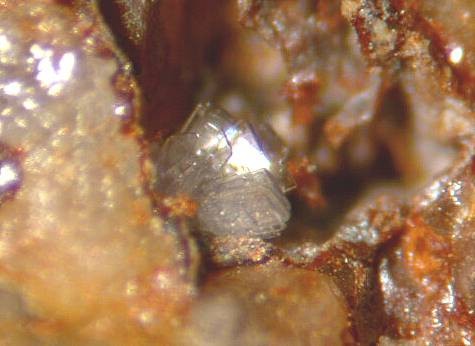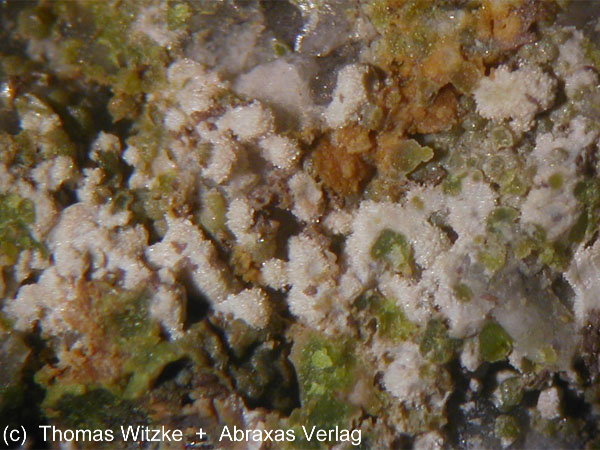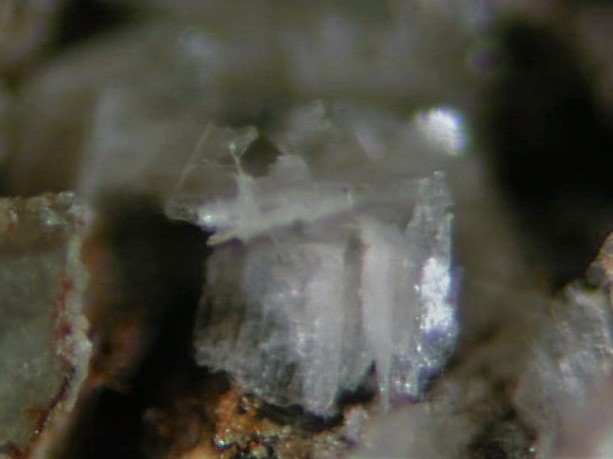Schieffelinite
A valid IMA mineral species
This page is currently not sponsored. Click here to sponsor this page.
About Schieffelinite
Formula:
Pb10Te6+6O20(OH)14(SO4)(H2O)5
Colour:
Colorless, milk-white
Lustre:
Adamantine
Hardness:
2
Specific Gravity:
4.98
Crystal System:
Orthorhombic
Name:
Named after Ed Schieffelin (1847-1897), the prospector who discovered the Tombstone mining district.
Isostructural with:
A chromate-analogue of schieffelinite is mentioned in Marty et al. (2010), and was later approved as chromschieffelinite. Chemically somewhat reminds adanite, northstarite, and eztlite.
Unique Identifiers
Mindat ID:
3566
Long-form identifier:
mindat:1:1:3566:4
GUID
(UUID V4):
(UUID V4):
48faa3e2-4eb5-4a7e-aa5d-545d3d9c15f5
IMA Classification of Schieffelinite
Approved
Approval year:
1979
First published:
1980
Classification of Schieffelinite
7.CD.55
7 : SULFATES (selenates, tellurates, chromates, molybdates, wolframates)
C : Sulfates (selenates, etc.) without additional anions, with H2O
D : With only large cations
7 : SULFATES (selenates, tellurates, chromates, molybdates, wolframates)
C : Sulfates (selenates, etc.) without additional anions, with H2O
D : With only large cations
Dana 7th ed.:
33.3.1.1
33.3.1.1
33 : SELENATES AND TELLURATES
3 : Compound Selenates and Tellurates
33 : SELENATES AND TELLURATES
3 : Compound Selenates and Tellurates
28.4.6
28 : Selenites, Selenates, Tellurites, and Tellurates
4 : Tellurates
28 : Selenites, Selenates, Tellurites, and Tellurates
4 : Tellurates
Mineral Symbols
As of 2021 there are now IMA–CNMNC approved mineral symbols (abbreviations) for each mineral species, useful for tables and diagrams.
| Symbol | Source | Reference |
|---|---|---|
| Sfl | IMA–CNMNC | Warr, L.N. (2021). IMA–CNMNC approved mineral symbols. Mineralogical Magazine, 85(3), 291-320. doi:10.1180/mgm.2021.43 |
Physical Properties of Schieffelinite
Adamantine
Transparency:
Transparent, Translucent
Colour:
Colorless, milk-white
Streak:
White
Hardness:
2 on Mohs scale
Cleavage:
Very Good
Easy on {010}
Easy on {010}
Density:
4.98(12) g/cm3 (Measured) 5.15 g/cm3 (Calculated)
Optical Data of Schieffelinite
Type:
Biaxial (-)
RI values:
nα = 1.897 nβ = 1.940 nγ = 1.942
2V:
Measured: 24° , Calculated: 22°
Max Birefringence:
δ = 0.045

Image shows birefringence interference colour range (at 30µm thickness)
and does not take into account mineral colouration.
and does not take into account mineral colouration.
Surface Relief:
Very High
Dispersion:
r > v extreme
Optical Extinction:
X = b; Y = c; Z = a.
Chemistry of Schieffelinite
Mindat Formula:
Pb10Te6+6O20(OH)14(SO4)(H2O)5
Crystallography of Schieffelinite
Crystal System:
Orthorhombic
Class (H-M):
mmm (2/m 2/m 2/m) - Dipyramidal
Space Group:
Cmcm
Setting:
Cmcm
Cell Parameters:
a = 9.67 Å, b = 19.56 Å, c = 10.47 Å
Ratio:
a:b:c = 0.494 : 1 : 0.535
Unit Cell V:
1,980.35 ų (Calculated from Unit Cell)
Z:
16
Morphology:
Platy or scaly to 1mm
Crystal Structure
Load
Unit Cell | Unit Cell Packed
2x2x2 | 3x3x3 | 4x4x4
Unit Cell | Unit Cell Packed
2x2x2 | 3x3x3 | 4x4x4
Show
Big Balls | Small Balls | Just Balls | Spacefill
Polyhedra Off | Si Polyhedra | All Polyhedra
Remove metal-metal sticks
Big Balls | Small Balls | Just Balls | Spacefill
Polyhedra Off | Si Polyhedra | All Polyhedra
Remove metal-metal sticks
Display Options
Black Background | White Background
Perspective On | Perspective Off
2D | Stereo | Red-Blue | Red-Cyan
Black Background | White Background
Perspective On | Perspective Off
2D | Stereo | Red-Blue | Red-Cyan
View
CIF File Best | x | y | z | a | b | c
CIF File Best | x | y | z | a | b | c
Rotation
Stop | Start
Stop | Start
Labels
Console Off | On | Grey | Yellow
Console Off | On | Grey | Yellow
Data courtesy of the American Mineralogist Crystal Structure Database. Click on an AMCSD ID to view structure
| ID | Species | Reference | Link | Year | Locality | Pressure (GPa) | Temp (K) |
|---|---|---|---|---|---|---|---|
| 0018765 | Schieffelinite | Kampf A R, Mills S J, Housley R M, Rumsey M S, Spratt J (2012) Lead-tellurium oxysalts from Otto Mountain near Baker, California: VII. Chromschieffelinite, Pb10Te6O20(OH)14(CrO4)(H2O)5, the chromate analog of schieffelinite American Mineralogist 97 212-219 | 2012 | Otto Mountain near Baker, California, USA | 0 | 293 |
CIF Raw Data - click here to close
X-Ray Powder Diffraction
Powder Diffraction Data:
| d-spacing | Intensity |
|---|---|
| 9.778 Å | (100) |
| 3.426 Å | (60) |
| 3.250 Å | (60 broad) |
| 3.560 Å | (50 broad) |
| 3.338 Å | (50) |
| 3.033 Å | (50) |
| 2.934 Å | (50) |
Comments:
Joe mine, Tombstone, Arizona, USA. Data are from the type description.
Geological Environment
Paragenetic Mode(s):
| Paragenetic Mode | Earliest Age (Ga) |
|---|---|
| Stage 7: Great Oxidation Event | <2.4 |
| 47a : [Near-surface hydration of prior minerals] | |
| 47b : [Sulfates and sulfites] | |
| 47e : [Vanadates, chromates, manganates] |
Type Occurrence of Schieffelinite
General Appearance of Type Material:
Clusters of intergrown colorless or milk-white scales.
Place of Conservation of Type Material:
Natural History Museum, Paris, France.
The Natural History Museum, London, England, 1980,539.
University of Arizona Mineral Museum, Tucson, Arizona, USA.
National Museum of Natural History, Washington, D.C., USA, R18474.
The Natural History Museum, London, England, 1980,539.
University of Arizona Mineral Museum, Tucson, Arizona, USA.
National Museum of Natural History, Washington, D.C., USA, R18474.
Geological Setting of Type Material:
In a shattered quartz vein.
Associated Minerals at Type Locality:
Reference:
Williams, S.A. (1980) Schieffelinite, a new lead tellurate-sulfate from Tombstone, Arizona. Mineralogical Magazine: 43: 771-773.
Synonyms of Schieffelinite
Other Language Names for Schieffelinite
German:Schieffelinit
Spanish:Schieffelinita
Common Associates
Associated Minerals Based on Photo Data:
| 2 photos of Schieffelinite associated with Rodalquilarite | Fe2(TeO2OH)3(TeO3)Cl |
| 2 photos of Schieffelinite associated with Girdite | H2Pb3(Te4+O3)(Te6+O6) |
| 1 photo of Schieffelinite associated with Emmonsite | Fe3+2(TeO3)3 · 2H2O |
| 1 photo of Schieffelinite associated with Cerussite | PbCO3 |
| 1 photo of Schieffelinite associated with Chlorargyrite | AgCl |
| 1 photo of Schieffelinite associated with Ottoite | Pb2TeO5 |
| 1 photo of Schieffelinite associated with Flaggite | Pb4Cu2+4Te6+2(SO4)2O11(OH)2(H2O) |
Related Minerals - Strunz-mindat Grouping
| 7.CD. | Argesite | (NH4)7Bi3Cl16 |
| 7.CD. | Campostriniite | (Bi3+,Na)3(NH4,K)2Na2(SO4)6 · H2O |
| 7.CD.05 | Matteuccite | NaHSO4 · H2O |
| 7.CD.10 | Mirabilite | Na2SO4 · 10H2O |
| 7.CD.15 | Lecontite | (NH4,K)NaSO4 · 2H2O |
| 7.CD.20 | Hydroglauberite | Na10Ca3(SO4)8 · 6H2O |
| 7.CD.25 | Eugsterite | Na4Ca(SO4)3 · 2H2O |
| 7.CD.30 | Görgeyite | K2Ca5(SO4)6 · H2O |
| 7.CD.35 | Koktaite | (NH4)2Ca(SO4)2 · H2O |
| 7.CD.35 | Syngenite | K2Ca(SO4)2 · H2O |
| 7.CD.35 | Antofagastaite | Na2Ca(SO4)2 · 1.5H2O |
| 7.CD.40 | Gypsum | CaSO4 · 2H2O |
| 7.CD.45 | Bassanite | Ca(SO4) · 0.5H2O |
| 7.CD.45 | Chinleite-(Y) | NaY(SO4)2 · H2O |
| 7.CD.45 | Chinleite-(Nd) | NaNd(SO4)2 · H2O |
| 7.CD.50 | Zircosulfate | (Zr,Ti)(SO4)2 · 4H2O |
| 7.CD.60 | Montanite | Bi2(TeO6) · nH2O |
| 7.CD.65 | Omongwaite | Na2Ca5(SO4)6 · 3H2O |
Other Information
Health Risks:
No information on health risks for this material has been entered into the database. You should always treat mineral specimens with care.
Internet Links for Schieffelinite
mindat.org URL:
https://www.mindat.org/min-3566.html
Please feel free to link to this page.
Please feel free to link to this page.
Search Engines:
External Links:
Mineral Dealers:
References for Schieffelinite
Reference List:
Williams, Sidney A. (1980) Schieffelinite, a new lead tellurate-sulphate from Tombstone, Arizona. Mineralogical Magazine, 43 (330) 771-773 doi:10.1180/minmag.1980.043.330.11
Fleischer, Michael, Chao, George Y., Francis, Carl A., Pabst, and Adolf (1981) New Mineral Names. American Mineralogist, 66 (1-2) 217-220
Kampf, A. R., Mills, S. J., Housley, R. M., Rumsey, M. S., Spratt, J. (2012) Lead-tellurium oxysalts from Otto Mountain near Baker, California: VII. Chromschieffelinite, Pb10Te6O20(OH)14(CrO4)(H2O)5, the chromate analog of schieffelinite. American Mineralogist, 97 (1) 212-219 doi:10.2138/am.2011.3909
Localities for Schieffelinite
Locality List
 - This locality has map coordinates listed.
- This locality has map coordinates listed.
 - This locality has estimated coordinates.
ⓘ - Click for references and further information on this occurrence.
? - Indicates mineral may be doubtful at this locality.
- This locality has estimated coordinates.
ⓘ - Click for references and further information on this occurrence.
? - Indicates mineral may be doubtful at this locality.
 - Good crystals or important locality for species.
- Good crystals or important locality for species.
 - World class for species or very significant.
(TL) - Type Locality for a valid mineral species.
(FRL) - First Recorded Locality for everything else (eg varieties).
- World class for species or very significant.
(TL) - Type Locality for a valid mineral species.
(FRL) - First Recorded Locality for everything else (eg varieties).
All localities listed without proper references should be considered as questionable.
China | |
| Jiuling Li et al. (2001) |
| Wang et al. (2019) | |
Russia | |
| Kasatkin et al. (2023) |
USA | |
| Rocks & Min.:57:12. |
| In the collection of Brent Thorne | |
| Rocks & Min.:57:16. +2 other references | |
| Anthony et al. (1995) | |
| Kampf et al. (2010) |
Quick NavTopAbout SchieffeliniteUnique IdentifiersIMA Classification Classification Mineral SymbolsPhysical Properties Optical Data Chemistry Crystallography Crystal StructureX-Ray Powder DiffractionGeological EnvironmentType Occurrence SynonymsOther LanguagesCommon AssociatesStrunz-MindatOther InformationInternet Links References Localities Locality List





 symbol to view information about a locality.
The
symbol to view information about a locality.
The 




Grand Central Mine, Contention-Grand Central Mine group, Tombstone Mining District, Cochise County, Arizona, USA